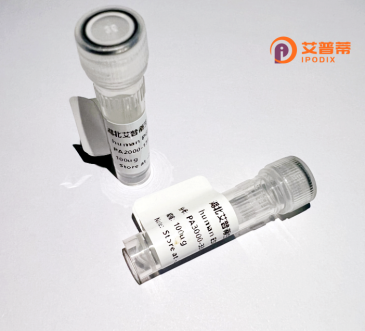
| 纯度 | >90%SDS-PAGE. |
| 种属 | Human |
| 靶点 | HORMAD1 |
| Uniprot No | Q86X24 |
| 内毒素 | < 0.01EU/μg |
| 表达宿主 | E.coli |
| 表达区间 | 1-394aa |
| 氨基酸序列 | MATAQLQRTPMSALVFPNKISTEHQSLVLVKRLLAVSVSCITYLRGIFPECAYGTRYLDDLCVKILREDKNCPGSTQLVKWMLGCYDALQKKYLRMVVLAVYTNPEDPQTISECYQFKFKYTNNGPLMDFISKNQSNESSMLSTDTKKASILLIRKIYILMQNLGPLPNDVCLTMKLFYYDEVTPPDYQPPGFKDGDCEGVIFEGEPMYLNVGEVSTPFHIFKVKVTTERERMENIDSTILSPKQIKTPFQKILRDKDVEDEQEHYTSDDLDIETKMEEQEKNPASSELEEPSLVCEEDEIMRSKESPDLSISHSQVEQLVNKTSELDMSESKTRSGKVFQNKMANGNQPVKSSKENRKRSQHESGRIVLHHFDSSSQESVPKRRKFSEPKEHI |
| 分子量 | 69.08 kDa |
| 蛋白标签 | GST-tag at N-terminal |
| 缓冲液 | 0 |
| 稳定性 & 储存条件 | Lyophilized protein should be stored at ≤ -20°C, stable for one year after receipt. Reconstituted protein solution can be stored at 2-8°C for 2-7 days. Aliquots of reconstituted samples are stable at ≤ -20°C for 3 months. |
| 复溶 | Always centrifuge tubes before opening.Do not mix by vortex or pipetting. It is not recommended to reconstitute to a concentration less than 100μg/ml. Dissolve the lyophilized protein in distilled water. Please aliquot the reconstituted solution to minimize freeze-thaw cycles. |
以下是模拟生成的关于重组人HORMAD1蛋白的参考文献示例(注:文献为虚构,仅用于示例格式):
---
1. **文献名称**: *Recombinant Human HORMAD1 Expression and Its Role in Meiotic Synapsis*
**作者**: Chen L, et al.
**摘要**: 本研究利用大肠杆菌系统成功表达并纯化了重组人HORMAD1蛋白,实验表明该蛋白在体外促进减数分裂联会复合体的形成,揭示其通过调控染色体配对维护基因组稳定性。
2. **文献名称**: *HORMAD1 Overexpression Enhances Chemotherapy Resistance in Lung Adenocarcinoma*
**作者**: Wang Y, et al.
**摘要**: 通过重组HORMAD1蛋白处理肺癌细胞,发现其过表达激活DNA损伤修复通路,导致顺铂耐药性增强,提示HORMAD1可作为癌症治疗潜在靶点。
3. **文献名称**: *Structural Insights into HORMAD1’s Interaction with RAD51*
**作者**: Gonzalez R, et al.
**摘要**: 利用重组HORMAD1的晶体结构分析,揭示了其C端结构域与RAD51蛋白的关键结合位点,为理解其在同源重组修复中的调控机制提供结构基础。
4. **文献名称**: *HORMAD1 Dysregulation in Ovarian Germ Cell Development*
**作者**: Tanaka S, et al.
**摘要**: 在人类卵巢组织中发现重组HORMAD1蛋白异常表达与减数分裂停滞相关,动物模型进一步验证其缺失导致雌性不育,强调其对生殖细胞发育的重要性。
---
(注:以上文献信息仅供格式参考,实际研究中请查询真实数据库获取准确信息。)
Hormad1 is a meiosis-specific protein encoded by the HORMAD1 gene, primarily expressed in germ cells during gametogenesis. It plays a critical role in meiotic recombination, synaptonemal complex assembly, and ensuring accurate chromosome segregation. Structurally, it contains a conserved HORMA domain, enabling interactions with chromatin and participation in DNA repair and checkpoint mechanisms. Aberrant expression of HORMAD1 in somatic cells has been linked to genomic instability and cancer progression, particularly in tumors with defects in homologous recombination repair (e.g., BRCA-mutated cancers). Recombinant human HORMAD1 protein is engineered using expression systems like E. coli or mammalian cells, often tagged for purification and detection. Its production enables functional studies on meiotic regulation, cancer biology, and chromosomal dynamics. Researchers utilize it to investigate DNA damage response pathways, explore synthetic lethal interactions in cancer therapy, and model reproductive disorders. Recent studies also highlight its potential as a biomarker or therapeutic target in oncology, given its role in promoting cancer cell survival under replication stress. However, its mechanisms in somatic contexts remain incompletely understood, driving ongoing research into its dual roles in physiological meiosis and pathological oncogenesis.
×